Today is the 30th anniversary of the release of The Running Man, a movie that asks what a Philip K. Dick story would look like if it had been made by a Joel Silver type. It's ultimately a mid-tier Arnold movie in terms of notoriety, but also one which is undergoing a certain re-appreciation as of late, especially as its vision of a future ruled by reality TV has sadly come to pass. Here's the story of how it got made.
It all started when an independent producer happened upon an interesting Richard Bachman book.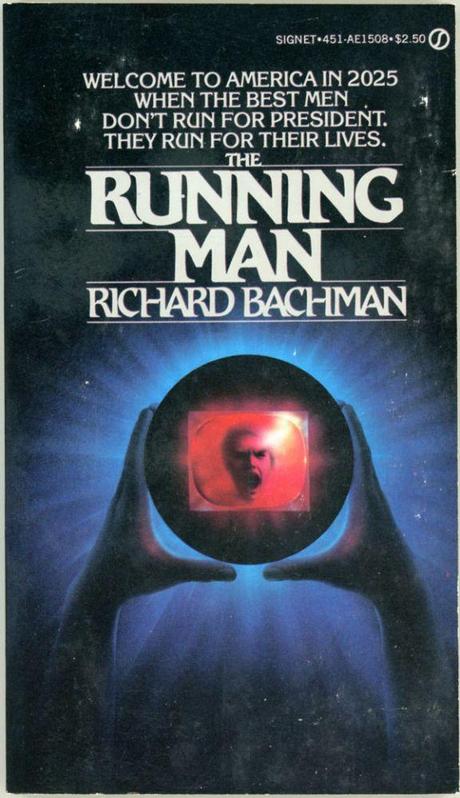
We know that because a DC bookseller put his Sherlock hat on and figured it out in 1985. But that hadn't happened yet when George Linder, who owned the country's largest supplier of lightweight wheelchairs, came across The Running Man in an airport bookstore. He'd never heard of Bachman nor did he have any reason to question his identity. He simply thought he'd found a good book that would make for an even better movie, thus offering him the perfect opportunity to try a new career as a film producer.
As he told Cinefantastique, "I contacted the author's agent and was a bit taken aback to learn that he was asking a comparatively great deal of money for the option of a book which had less than 100,000 copies in print. I mean, who had ever heard of 'Richard Bachman'?"
But he played ball with the publisher and agreed to a $20,000 up-front payment with a built-in bigger bump down the road should the film actually get made. Next, he surveyed the Hollywood landscape to find the right partners.
Stephen King wouldn't let them use his name.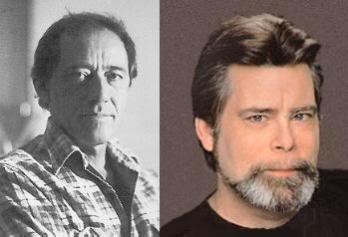
Linder's search led him to Rob Cohen and Keith Barish, who were then in the process of setting up a slate of ten big-budget genre pictures through their new company, Taft/Barish. Cohen had a decade of experience as a studio executive at Fox TV and Motown Production as well as several years as a producer and TV director; Barish had just earned his first producing credits (most notably for '81's Endless Love and '82's Sophie's Choice).
"When [Linder] took it to them," Running Man 's screenwriter Steven de Souza recalls, "Cohen said, 'Boy, you made a lousy deal. Why is the second payment [on the option] so high?' That's when they realized it was Stephen King."
Linder couldn't believe it, "I felt like I'd found a Rembrandt in K-Mart!" Cohen agreed, admitting he eventually bought Linder's pitch "with the understanding that we could use King's name on the advertising."
Not so fast. King liked the money they had to pay for the option, but otherwise wanted nothing to do with them, telling Cinefantastique, "It was totally out of my hands. I didn't have anything to do with the making [of the movie]...it doesn't have much in common with the novel at all, except the title." So, he stopped them from using his name in any advertising, robbing the world of the potentially bizarre sight of near peak era Stephen King and Arnold Schwarzenegger's names showing up on the same posters and in the same trailers together.
Casting Arnold forced them to rethink the story.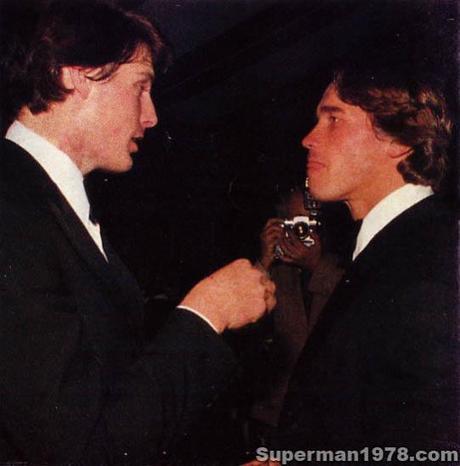
Arnold doesn't really do "everyman." No one who looks and sounds like that can. However, the Ben Richards of the King novel is exactly that: a malnourished everyman with a sick child and wife turning tricks to get medicine. Due to the worldwide economic depression, he can't get work and has to go on the Running Man show as a last resort to hopefully save his family. Arnold's not the first name that comes to mind based on that description, which is why they originally thought of Christopher Reeve for the role. Some reports indicate he was even officially cast by the project's original director, George Pan Cosmatos.
As soon as they put Arnold in the lead role, though, everything about the story had to be adjusted. de Souza describes it this way: "I didn't have to destroy King's vision, but instead tailor the movie to Arnold like a suit." So, Ben Richards became a single, disgraced former law enforcer with a tendency toward puns and a love of cigars. It's antithetical to the original intent, but so was turning the Terminator from an anonymous infiltration device to a physical specimen who stands out in any crowd. Look at how well that worked out for everyone.
Plus, having Arnold's name attached helped them raise funding through foreign pre-sales. When that wasn't enough Linder sold his wheelchair company to cover the rest. The original budget was set at $10m ($5m less than what Predator was made for that same year, btw). It would eventually grow to $27m, $5m of which went to covering Arnold's salary.
King's version of the Running Man needed some pizazz."The game show portion in the book, the studio portion is like 5 pages," de Souza told an Alamo Drafthouse Los Angeles audience during a post-screening Q&A earlier this year. "The host is a different guy from the producer. The producer's really the prick. But the game show in the book is like a 1950s game show. Ever see reruns of You Bet Your Life with Groucho Marx? That's what the game show is like. There's a guy with a microphone, and a girl comes out with a box around her neck. The runners pick an envelope, and that gives you a head start, 10 minutes or 20 minutes."
All of that had to go. The Running Man needed to be a grotesque, but believably slick and entertaining affair, marrying the production trends of the late 80s and the dystopian ideas of Rollerball and Death Race 2000 with the bloodlust of the Roman Coliseum. Moreover, participation in the game needed to be punitive, not voluntary, to up audience sympathy for the unjustly accused hero.
De Souza followed his impulses and thought up the craziest things imaginable all the while remembering he was living in a world in which an actor, Ronald Reagan, had become President. What if, in the future, the President has an agent just like an actor? Also, probably without realizing he pulled from video games, essentially putting the diverse set of heroes through a series of boss battles against figures who come off like a cross between Mega Man villains and WWF heels.
The original director wanted to lean harder into the dystopia of it all.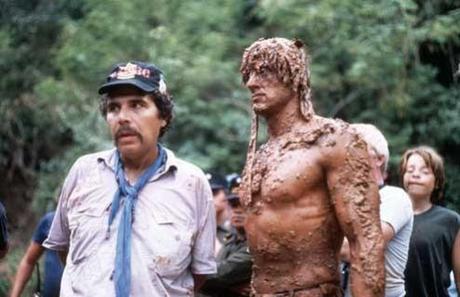
Greco-Italian director George Pan Cosmatos had made two movies since relocating to America, the first a horror film (1983's Of Unknown Origin) which came and went, the second a little arthouse indie called Rambo: First Blood Part II (1985). I think some people saw that one (I say sarcastically), certainly enough for it to help Cosmatos get the gig to direct Running Man.
Once on board, he pushed even harder into the totalitarianism of the plot and made the love interest (eventually played by Maria Conchita Alonso) a revolutionary who teaches Richards and opens his eyes to the need for action. Mostly, he sorta made it more like Rambo. As de Souza recalls:
"Cosmatos' family suffered under the Nazi occupation in Greece. In the draft I did for George, there were roundups, there were concentration camps. He went way into that. His vision was that the 1% people lived in a complete biodome. He wanted to film all the upscale scenes in the Edmonton Mall, the biggest shopping center in the world at that time. So we were going to shoot in Canada and we scouted it. When [Richards] broke out of the city, there was going to be a river raft chase. I think he was just trying to get the movie back in the wilderness where he had done Rambo. He wanted the whole chasing part of the game to be in the wilderness."
This script was budgeted at $27m. When the producers demanded cuts to make it shootable on an $18m budget Cosmatos walked. Or at least that's the story de Souza tells now.
Rob Cohen told Alan Jones of Cinefantastique, Starburst and Radio Times a different story back in the 80s: "[Working with Cosmatos was] the worst experience I've ever had in the business. [He] was the least talented, least cooperative and the most horrible person I've ever had dealings with. We fired him after spending $700,000 on the picture."
He would not be the last director fired from the movie.
For a minute they almost went Truman Show with it.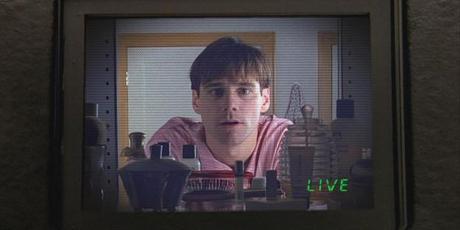
So, Cohen decided to move on to Ferdinand Fairfax, a Brit with one movie to his name but several TV shows. Given that work history, perhaps it's not surprising Fairfax's pitch was to do what Peter Weir would later do with the first half of The Truman Show and simply make the show-within-the-movie, i.e., the actual Running Man broadcast, the movie.
Then they fired the director a week into filming."[Fairfax] had an interesting idea that the movie should be the actual broadcast, which would have had some narrative problems because how did [Ben Richards] get in trouble and stuff like that," de Souza said. "He was making it very British. He said on an English crew, you have a tea lady who comes around with a cart of tea and biscuits. When the tea lady came through, the show stopped the crew stopped, the stalker stopped and the runners stopped and they all took a break, then started up again. It was kind of a Monty Python bridge too far. Before you could say, 'What is the capital of Assyria?' he was gone."
They finally found their man with Andrew Davis, a longtime cinematographer who had recently branched out into directing, helming a forgotten slasher flick ( The Final Terror) and one of the apparently good Chuck Norris movies ( Code of Silence). Movies like Above the Law, Under Siege and The Fugitive were still in his future. Running Man was the next step up for him in his career, and it started off well.
He worked with de Souza to streamline undo all of the eccentricities Fairfax and Cosmatos had brought to the script. He handled pre-production duties, saw to the hiring of Paula Abdul to choreograph the dance numbers, the casting of Mick Fleetwood and Dweezil Zappa to play revolutionaries, Richard Dawson to play Killian, and generally got the movie ready to film by its September 1986 start date.
Once that date came they spent the first three days filming the prison break. Sometime after that, they shot the ice rink battle.
Then he was fired.
Yeah. About that, they were only eight days into the shoot, and Davis was already $8m over budget. Cohen's patience was wearing thin, and it disappeared entirely when he watched the dailies for the ice rink sequence.
As de Souza explained:
"In a meeting earlier, Andy said, 'Listen, I have a great idea. At the end of the movie, when they break into the studio, they're cornered. They're trapped. Then Arnold reaches into his pocket and takes out one of the exploding hockey pucks, throws it and kills the guards. Rob and I look at each other and he says, 'That makes Arnold pretty shitty. He had this thing in his pocket for the whole movie where the whole supporting cast is getting killed and he uses it to save his own ass. We're not doing it.' Then he's behind schedule several days. He shot and improvised that scene and had Arnold pocket one of the hockey pucks."
Cohen showed the footage to de Souza and Schwarzenegger and declared they had a problem. However, Schwarzenegger claims the actual decision to fire Davis was made without consulting him and transpired when he was away from set promoting a bodybuilding competition. When he came back, he was incensed and now concludes, "With such a terrific concept, Running Man should have been a $150 million movie. Instead, it was totally screwed up by hiring a first-time director and not giving him enough time to prepare."
Starsky to the rescue.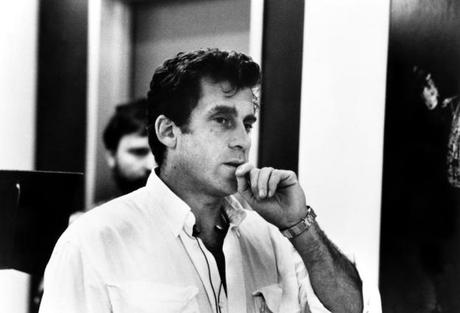
Which is exactly what he did. Given little more than two days to prepare and no real authority to offer substantive notes on the script, Glaser steadied the ship and got the film done, later telling Cinefantastique, "Directing is basically problem-solving. When you come into something in the middle like I did, your problem solving goes up about 300%."
All told, the shoot took 61 days and finished $17m over budget, or at least $17m over what they had originally expected to spend when this was just supposed to be a small movie sold on the marketability of Stephen King's name.
Don't confuse test screen audiences. They don't like that. This is how the film ends, but it's not how it was originally sequenced:The idea for the Killian-fakes-their-deaths twist partially came from Cohen's past experience working on The Sting and its infamous fake out finale. It also owes a fair bit to de Souza and Cohen's interactions with an effects company which offered to use a new-fangled thing called "synth thespians" to animate some of the more dangerous stunts in order to preserve safety for cast and crew. The technology, unfortunately, only worked if people's heads were perfectly still, making it entirely impractical for the film as a whole. However, what if someone like Killian in the future could use just such digital manipulation to pacify audiences? Not just that, what if we use that technology to fool everyone, including the people watching the movie?
Thus, Jesse Ventura's massacre of Maria Conchita Alonso and Arnold Schwarzenegger was originally scripted, shot and edited to take place before the film reveals it to actually be the work of Killian and his digital artists.
They ran that version of the film, albeit in a rough cut with unfinished effects and some of Arnold's lines ADRed by de Souza himself, in front of a test screening audience of 700 randomly selected Palm Springs residents and watched from the back when the big moment came. As expected, the audience reacted exactly as the in-studio audience does in the film: They were stunned to see Alonso's neck snapped, and then screamed for blood, fully expecting Arnold to quickly and brutally avenge her murder. Once Ventura got him too they didn't know what to think.
This was the ride de Souza wanted to take them on before giving them the relief of cutting to Alonso and Arnold watching their own deaths in disbelief from the Revolution's underground headquarters. The problem was once you trick an audience like that you risk losing some of them either to confusion or resentment. Plus, exposing it to them in an unfinished format with crucial effects shots missing only enhanced the confusion, though not significantly.
Only around 1.7% of the surveyed test screening attendees said they didn't understand how the people in the movie were fooled by the swerve, but that was enough to make everyone nervous. So, the scenes had to be resequenced to make sure we know the big twist before the audience watching the Running Man show does.
Damn you, Predator!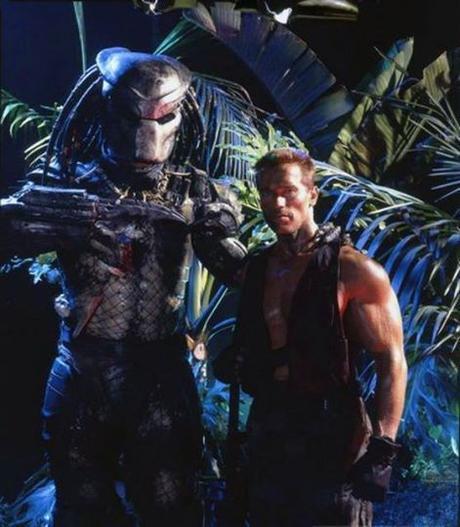 The Legacy
The Legacy 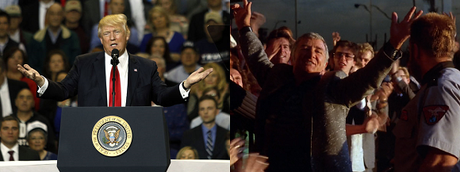
That was the right choice, financially. Predator made more money and got better reviews, turning Running Man into more of an afterthought snuck in-between Arnold's big box office breakthroughs - Predator and Twins. Roger Ebert seemed to at least mildly appreciate Running Man's charm, reserving particular praise for Dawson's performance, "Playing a character who always seems three-quarters drunk, Dawson chain-smokes his way through backstage planning sessions and then pops up in front of the cameras as a cauldron of false jollity. Working the audience, milking the laughs and the tears, he is not really much different than most genuine game show hosts - and that's the movie's private joke."
Others were quick to criticize the film for, as Monthly Film Bulletin put it, "providing exactly the same kind of violent spectacle that it criticises Killian for manufacturing and twenty-first-century audiences for watching."
But beneath Running Man's junk cinema exterior lies a genuinely good idea, and in recent years it has been the subject of critical reappraisals by FilmSchoolRejects, The AVClub, and DenOfGeek, among many others. It has even been used as the centerpiece of an academic documentary about the artifice of reality TV, somewhat ironic since both Alonso and Schwarzenegger have now had their own stints as reality show hosts:
The BBC, Vice, and The Atlantic all took the occasion of Trump's inauguration to look back at Running Man version of 2017, loathing how many similarities they found. de Souza is right there with them, telling Vice he's most distressed by the one major thing he got wrong (other than there being a pyramid in LA and the world still using cassettes): "The biggest downer of this movie is the idea that when the video tape surfaces showing that Killian has lied, everyone is instantly outraged and rises up. Apparently, it doesn't work that way. We've heard the tapes and seen the tapes, and it's had no effect. In real life, everyone goes right back to Facebook."
In real life, problems aren't solved by puns, no matter how hard Schwarzenegger sells "Hey, Killian, here's your Subzero, now plain zero." But to be discussed with any degree of relevance and reverence thirty years later is pretty good for a movie which nearly tripled its budget and went through 4 directors, one of whom had as little as 2 days to prepare.
BOX OFFICE- BUDGET: $27m
- OPENING WEEKEND: $8m (stayed #1 for two weeks)
- TOTAL GROSS: $38m domestic
- CONTEXT: By the late 80s, all of Arnold's starring movies (not counting Hercules in New York, of course) had grossed at least $30m except for 1986's Raw Deal, which was his first true flop (just $16m total). Then he hit a career high with 1987's Predator, which grossed the equivalent of $136m at today's ticket prices and finished its run as the 12th highest grossing film of the year. If not for that, Running Man could have been seen as a nice rebound for him, following Raw Deal up with something which performed more like his career average. However, given Running Man's proximity to Predator as well as its out-of-control budget it went down as a box office disappointment.
- INFLATION: At 2017 ticket prices, Running Man's domestic total converts to $86m, which is Terminator: Genisys ($89m)/Blade Runner: 2049 ($88m) territory for today's sci-fi.
Sources: I Was There Too, Creepshows: The Illustrated Stephen King Movie Guide, BoxOfficeMojo

